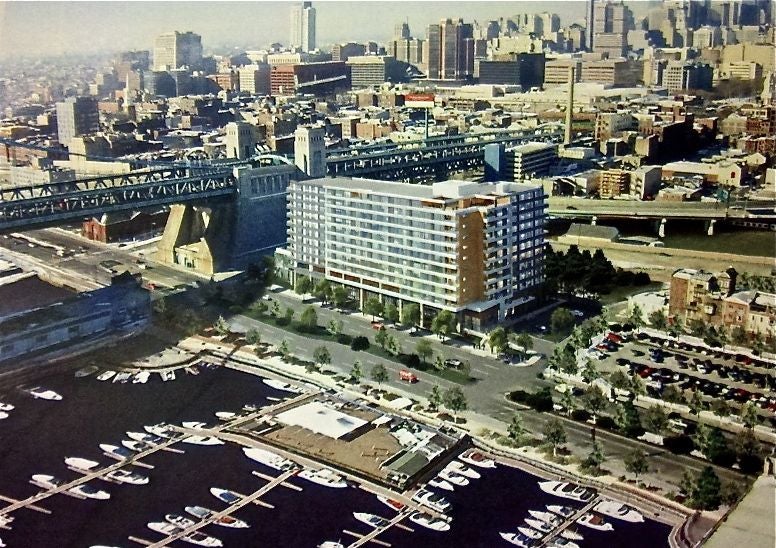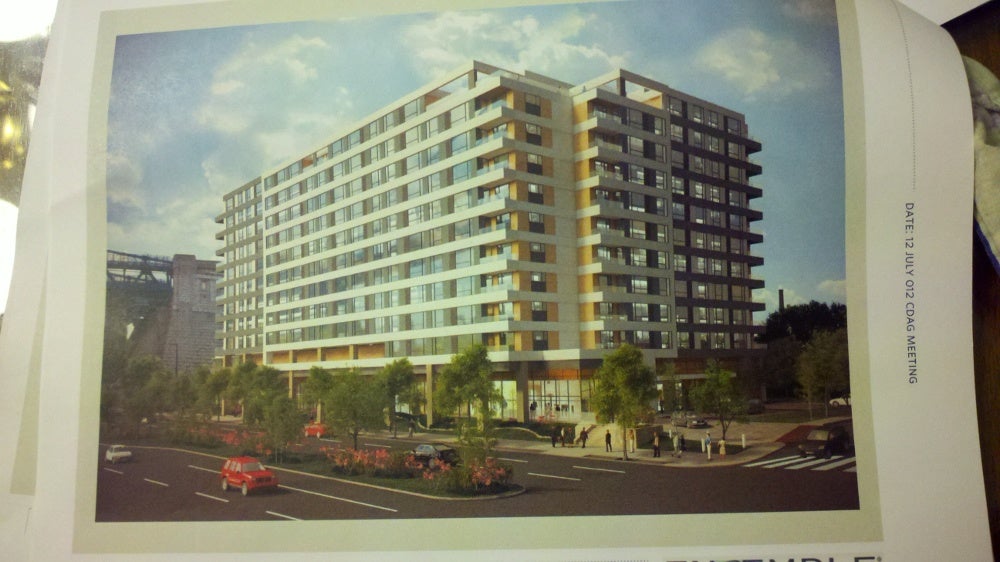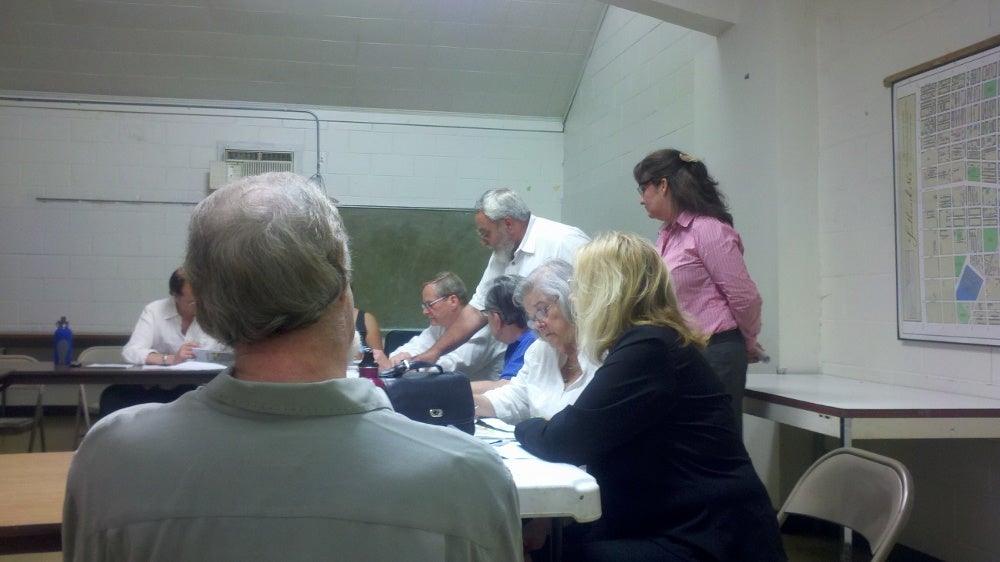CDAG hears from Ensemble on Marina View and project for Piers 34/35 and Pier 40
Ensemble Real Estate’s Louis Cicalese told the Central Delaware Advocacy Group that he made massing changes to bring the Columbus Boulevard facade of his proposal for a 12-story residential development at Pier 34 down to 100 feet, out of respect for the 100-foot maximum the Central Delaware Master Plan calls for.
Also in response to the city’s long-term vision for the waterfront, Cicalese said he’s “got almost 90 percent active retail” on the ground floor in the current version of his proposal – the fourth iteration.
“I want to work with the community, I don’t want to work against the community,” Cicalese said.
Cicalese and his team made a preliminary, information-only presentation about his plans for Piers 34 and 35 to the Philadelphia City Planning Commission last month. At that time, he told commissioners he would be seeking an exemption from the 100-foot height limit.
The developer talked about his Pier 34 plan at the tail end of a longer discussion about the Marina View apartment project at 230 N. Christopher Columbus Boulevard, near the Ben Franklin Bridge – a roughly 130-foot tall project the PCPC already approved, with permission to exceed the 100-foot cap.
CDAG and Old City Civic Association had concerns about the project’s height and massing, and the amount of retail space on the ground level, facing Columbus Boulevard. Planning commissioners had those same concerns, which is why it was so perplexing and frustrating when they approved the plan of development and the height exemption, anyway, CDAG Chairman Matt Ruben said.
“Most neighborhood zoning committees would say, ‘We like the idea, thank you, come back next month or next week with some responses to these concerns that we still have,’” Ruben noted. “What we heard from the planning commission was, ‘We have these concerns, but you have your approval. Go on your merry way.’”
Ruben told Cicalese this wasn’t about him, directly, and offered congratulations on the approval. “But I think it’s a huge concern for CDAG that the planning commission has voiced these concerns but actually not done anything about them.”
Ruben noted that commissioners voiced similar concerns during the information session on Ensemble’s plans for Piers 34 and 35 and Pier 40. CDAG members agreed Thursday that they must push commissioners to either just say no to anything that goes against the master plan, or grant rare exceptions only after a developer has clearly shown an exception is needed.
Piers 34 and 35 are part of a single proposed development. Ensemble hopes to remove the partially collapsed Piers 34 and 35, replace them with a new pier, and build a 204 unit, 12-floor residential building on top of it. This would require a bunch of federal and state permits, along with planning and zoning approvals.
Ensemble wants to build a 215-foot tall, 200-unit residential development on the land at the foot of Pier 40, and would be happy to give the pier to the city – a gift some planning commissioners and the chair, Deputy Mayor for Economic Development Alan Greenberger, doubted the city would want.
Cicalese politely said he disagreed with Ruben’s assessment of how things went down at the Planning Commission.
“We spent hundreds of thousands of dollars, and many hours,” to show why Marina View couldn’t strictly adhere to the ideals of the master plan, Cicalese said.
Cicalese and architect Megan Delevan shared some of that with CDAG Thursday. The building had to be elevated because it sits in a floodplain. As a result, on some sides, there is a grassy berm that is divided by a pedestrian walkway. Earlier versions called for a structural pedestal instead, but that was replaced in response to feedback from commissioners and the community.
There is some retail space along Columbus – about 55 or 60 percent, Cicalese said. The remainder, the area closest to the bridge, is sheathed with opaque glass and is essentially bicycle storage.
Cicalese said he’s been a city developer for a long time, and he’s been told that the waterfront was on the verge of getting a whole lot of pedestrian traffic. He indicated there have been some changes this time: “We’re thrilled by the Race Street Pier. We’re thrilled by the entertainment building they are putting in there. All of that.” Cicalese said he’s offered to chip in some money to help make the area more pedestrian friendly, and noted that in response to Waters Edge residents, changes are continuing to be made to the plan to provide a well-lit, safe way for residents to move between Waters Edge and Old City.
But the numbers aren’t there yet, he said. “To the extent that retail becomes a viable economic component (in the future), that space could be converted to retail,” Cicalese said.
CDAG members urged him to, at minimum, make the space retail-ready, so business owners wouldn’t be dissuaded from locating in the space.
Ruben’s message came right out of a classic baseball movie: If you build it, they will come. He pointed to the building at 444 N. Fourth St., where Cafe Estelle is located. This was not an area thought to be ideal for commerce, Ruben said. Now Cafe Estelle is a brunch destination. Civics have been telling developers to include active uses on their ground floors, and even if they sit vacant for six months, so be it, Ruben said. Developers make their money off the residential component, anyway, he noted.
CDAG gave Cicalese and his team a round of applause after their presentation. They said they appreciate changes he has made in response to the master plan, and also thanked him for asking to come talk to them about his projects, something not every developer does.
In other CDAG business:
-Member Richard Wolk gave an update on the Delaware Avenue Traffic Study being done by the Delaware River Waterfront Corporation and the city’s transportation and utilities department. The biggest component of this study – which DRWC has characterized as a small chunk of what needs to be done – will be changing the timing of the lights. The city will be able to adjust the timing, and even create special settings for different times of day or special events, Wolk said.
However, the wires that work these lights are old-school copper, not fiber optic, he said. That means changes cannot be made remotely.
Ruben noted that there is conduit in place, and while threading fiber optic isn’t free, placing the conduit is the most expensive part. He suggested the city seek a donation from Verizon.
The idea is to adjust traffic signals so as to best accommodate both pedestrians and vehicles. During peak traffic hours, the goal is to help traffic move more smoothly. During off-peak hours, the goal is to slow it down – and prevent drag racing.
Many CDAG members, especially residents of the southern end of the Central Delaware, noted the roadway is a nightmare for pedestrians. Members Mary Stumpf, Dianne Mayer and Rene Goodwin noted that parents with kids, baby strollers and shopping carts in tow are often trying to cross near the big box stores, and often can’t make it across before the signal changes. It’s also hard for people with mobility issues, they noted.
CDAG has been trying to get preliminary results of the study, with no luck. The draft of the study is supposed to be released to the public in coming weeks, so Ruben said CDAG needs to prepare to make comments then.
-Wearing three different hats, CDAG member Rob Kettell has studied the in-the-works sign control legislation that will eventually become part of the new zoning code. Kettell has been involved via CDAG, but also Old City Civic and the Crosstown Coalition. A letter and bullet points regarding CDAG’s concerns, compiled by Kettell, was approved by the group Thursday and will be sent to First District Councilman Mark Squilla, Planning Commission Deputy Executive Director Eva Gladstein and Greenberger. CDAG’s wishes include prohibiting billboards within the Central Delaware Overlay District and establishing design review for signs on some buildings. They are also recommending special regulations for digital signs. See the letter, here, and the proposed signage legislation with CDAG’s proposed revisions, here.
-There was a brief discussion of the Pennsylvania Gaming Control Board’s decision to open Philadelphia-only bidding for a second casino. CDAG has never taken a position on casinos, per se, but has expressed concerns about design and location. Many around the table had actively opposed the never-built Foxwoods and/or open-and-expanding SugarHouse through other organizations.
Ruben said that the only proposal that’s more than a rumor at this point is out of CDAG’s jurisdiction – Bart Blatstein is floating a proposal to include a casino in part of his redevelopment of the former Philadelphia Inquirer building on North Broad Street. But there’s a long time between now and the application deadline in November, he said. Things could change.
Contact the reporter at kgates@planphilly.com
WHYY is your source for fact-based, in-depth journalism and information. As a nonprofit organization, we rely on financial support from readers like you. Please give today.






